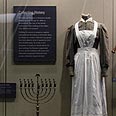
With 126,000 visitors in 2011 and declines in this year's first quarter, attendance has not come close to original expectations of 250,000 annually. The flurry of grand-opening hoopla in late 2010 and early 2011 has faded, taking the attention of visitors and their dollars elsewhere.
There was an initial surge into the museum's 25,000-square-foot exhibition space, in which the story of Jewish America is told through artifacts, documents, photographs, biography, and art – from feminist politician Bella Abzug's signature hat to a 1789 acrostic prayer celebrating ratification of the Constitution and spelling Washington in Hebrew.
But that surge – into an institution billing itself as "the only museum in the nation dedicated solely to telling the story of Jews in America" – soon ebbed. Memberships fell from a reported high of 18,000 a year ago to what officials say is a stable 15,000.
Fundraising, with sluggish economic growth the norm nationwide, has proven a challenge since day one at the new digs at Fifth and Market streets.
In July, amid these difficulties, the museum named Ivy L. Barsky chief executive. Barsky had already been the museum's director and chief operating officer for about a year, after serving as deputy director of New York's Museum of Jewish Heritage – A Living Memorial to the Holocaust.
While she had never run a museum, Barsky has started to address some of the most glaring problems facing the facility. A new strategic plan has been virtually completed, laying out educational, program, and operational goals for the next several years.
While seven staff members were let go this year, Barsky, 48, says at least some of the layoffs were not the result of out-and-out belt-tightening. There is no development director, but an appointment is near, she said; searches are also in the works for heads of education, marketing, and public relations, all posts that are vacant.
Barsky maintained that a year from now, staffing levels would be back up to about 54 positions, which is where they were before layoffs and what she called realignment.
No post-construction planning
Barsky did not respond to requests for information about her salary. Her predecessor, Michael Rosenzweig, who left the museum this year, had an annual compensation package totaling $434,515, according to the museum's 2010 tax return.
Both Barsky and Ron Rubin, co-chairman of the museum's board of trustees, said there would be no deficit at the end of this fiscal year. Whether that means annual fundraising will fill any looming revenue gap is less clear. The museum has a small endowment, $10 million to $12 million, that could be used to patch any budget holes.
Asked if board members were prepared to step up and help the museum meet its annual needs, Rubin said he "can't commit the board, obviously."
He continued, "We will find ways to meet our obligations. I think there are certainly some members of the board who are in a better position to do that than others."
The museum, according to Barsky, has an annual operating budget of about $11 million, including construction loan indebtedness of about $1.4 million.
About half that operating budget must be met by fundraising, she said, a daunting task.
"This is not a challenge that's unique to the National Museum of American Jewish History," said Tom Kaiden, head of the Cultural Alliance of Greater Philadelphia. "Retrenchment comes with a steep recession," he said, noting that virtually all city nonprofits face a difficult fundraising climate.
But the problems of the Jewish museum, which raised about $156 million to build its facility, have been compounded by faulty or nonexistent post-construction planning, its officials readily concede.
"Every ounce of energy went to building out this building and building out a world-class core exhibition," Barsky said. "And I think it's accurate to say that probably that same kind of energy should have been spent on determining what the programs were, determining what the model was that was going to sustain the organization into the future.
"But there was a single intense focus that was really bold but not very wide. ... And we are now having to really go back and establish some of the other things that, yes, as a museum professional, I would have loved to see happen a couple of years ago. There's only so much lamenting I'm going to do that it wasn't done."
Spirit of hope and courage
Barsky and Rubin both said the museum was seeking to broaden its appeal by exploring the implications of its mission. What is Jewish American history? How does it relate to the histories of other immigrant groups? How does the experience of Jews relate to the experiences of other religious groups?
Toward that end, special exhibitions and programs seek, at least in part, to define the Jewish experience as a broadly American experience. The current exhibition "To Bigotry No Sanction: George Washington and Religious Freedom," focuses on letters Washington wrote not only to Jews but to Quakers, Catholics, and other religious groups.
Beginning in January, the museum will host "Beyond Swastika and Jim Crow: Jewish Refugee Scholars at Black Colleges," a virtually unknown story touching both African American and Jewish American history.
Barsky and Romona Riscoe Benson, head of the African American Museum in Philadelphia, are working on joint programming and ticket deals aimed at introducing new audiences to each museum. The African American Museum, in fact, will bring back "381 Days: The Montgomery Bus Boycott Story," a traveling Smithsonian exhibition it first showed last year. It will run during the Jewish museum's "Swastika and Jim Crow" exhibition.
"Part of our strategic plan is really about looking at this American spirit of hope and courage, of leadership and service," said Barsky, "and if you look at the stories in our core exhibition, that's what all of them are about in the end."















